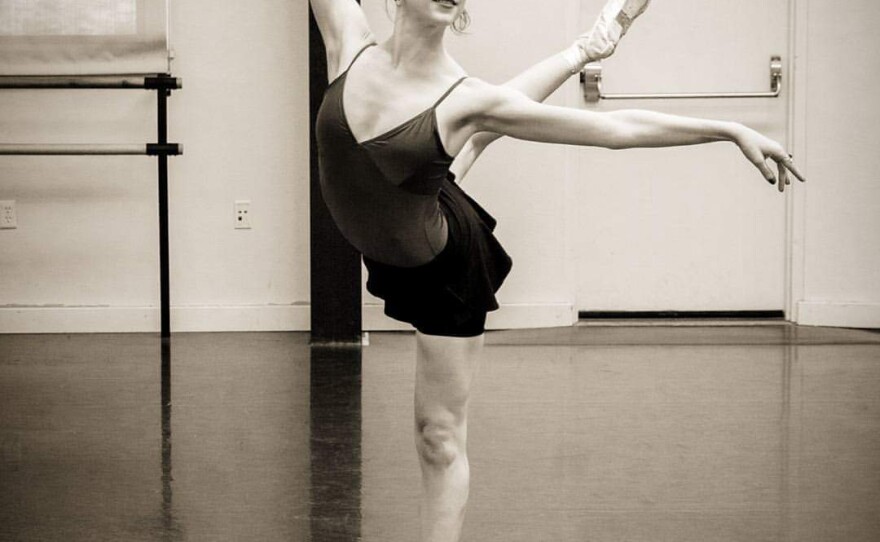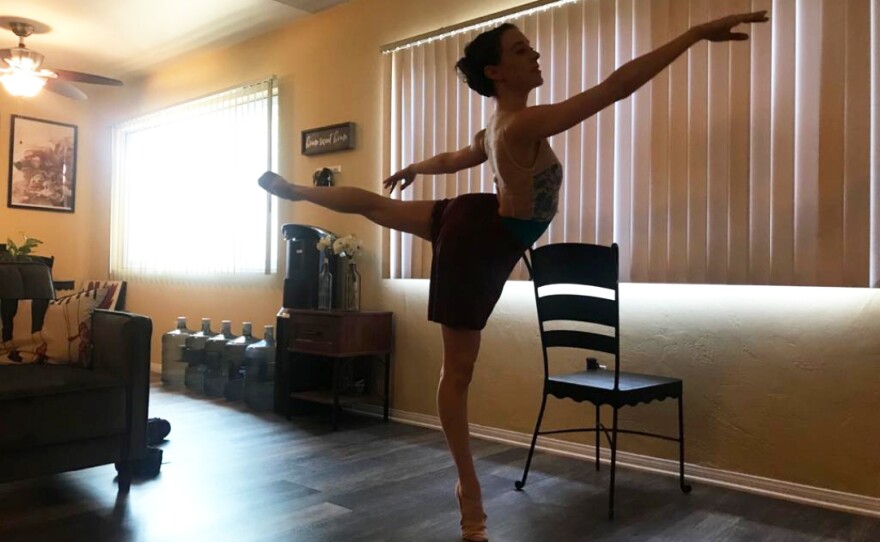Imagine a world where scorned or anguished women exist together in harmony, free of men, save only for when they gang up on one to haunt him. That's right, these women, known in folklore and myth as the "wilis," are the ghosts of young women who died before they were wed or were betrayed by their lovers.
These unearthly wilis — and their appearances in Victor Hugo's "Fantômes" poem and Heinrich Heine's book, "De l'Allemagne" — inspired Adolphe Adams' 19th century ballet, "Giselle," which the San Diego Ballet was set to open on Saturday.
Giselle was born with a weak heart, and when Albrecht, her true love, betrays her — turns out he's actually a duke masquerading as a peasant boy — the heartbreak is too much and she dies. She doesn't just die, first she famously goes mad. And that's just the end of the first act.
Stephanie Maiorano, a dancer with the San Diego Ballet, has been waiting to dance the madness scene for a long time. "I've been working on that in my room since I was 15," she said. Originally steeped in the tale's eastern European origins, the San Diego Ballet's artistic director Javier Velasco has transformed the story, setting it in Spanish Colonial San Diego.
Maiorano performed as Giselle when the company produced the second act during a showcase last year, so fans have seen her take on Giselle in Velasco's world, but this weekend was set to be the first time they've done the full ballet and the first time Maiorano would act as the human girl form of Giselle.
We've seen this sentence too many times: And then the pandemic hit.
"I'm actually doing less ballet, less dancing than I have in my entire life," said Maiorano. She's able to stay strong, doing pilates, barre work and whatever other home-based training she can do without a studio’s impact-resistant marley floor, but the mental impact is harder to handle. "I've always been a ballet dancer. I started ballet when I was 3. I trained extensively once I hit 11. Every single day I was at the studio, and it’s been like that until COVID happened, and I'm 33 now. So it's really been my whole life," she said. "This has turned my life upside down."
Maiorano will have to wait even longer to tell Giselle-the-wili's origin story. The San Diego Ballet's full production of Giselle has been rescheduled for next May.

For a dancer whose career means showing up to a studio each day, rehearsing, teaching and taking classes, Maiorano is in a holding pattern. She's teaching youth ballet classes online, but mourns the loss of true interaction and the ability to really see and correct the dancers' movements. But it adds structure and practice to her day. "It’s from 9 until 4 of just teaching. And doing pliés and tendus and dégagés and rond de jambes over and over and over again. When it’s all done, I sit on the couch, I plan my zoom meetings,” she said. “I feel like I've become very work focused now that I’m just stuck inside."
She has dabbled with taking classes online herself — and appreciates that she can study with dancers across the globe she wouldn't otherwise be able to study with — but it's not the same as in-person, in-studio practice, and Maiorano is also contending with being a ballet dancer without a stage.
In Giselle, when the wilis take the stage in the second act, it's a riot of hauntings, plus one of the earliest uses of the "ballet en blanc" device, when a group of dancers dressed head-to-toe in white dances in unison. But the story is one of forgiveness.
Interpreted as Lloronas in Velasco's production, the ghosts are as beautiful as they are vengeful. When Albrecht finally finds his way back to Giselle, the wilis want him to suffer, using Giselle as a lure. But Giselle begs for mercy from the ghosts, and a powerful scene unfolds between the betrayer and betrayed as Giselle and Albrecht share a dance.
"The music is so epic, so lush," said Maiorano, of Adolphe Adams’ original compositions. "As a dancer, it’s just such a rewarding role to have. Not all music is that beautiful." Giselle is a technically challenging role, but Maiorano said that she doesn’t even think about the steps while performing. "The music carries you through. It’s an out of this world experience," she said.
For this kind of method acting, she's only pulled out of the character when the audience applauds at the end. Losing the performance element of dancing is an adjustment, because a dancer's entire year is shaped by the rhythms of each show, whether it be summer showcases or Nutcracker season.
When asked whether she still has to force herself to work from home and commit to being a dancer each day even during quarantine, she said that it's a "24/7 job," regardless of performance schedule or COVID-19. "The way I eat, sleep, walk, whatever. I’m a ballet dancer. It's all the time."

After three months of quarantine and being limited by what practice was safe to do on the floor at home, Maiorano was able to sneak into a studio and instantly felt like herself again. "I can't tell you how relieved I was to see marley floor and the big mirrors and the bar," she said. When she danced again, she realized that after three decades of dancing, her body could weather this storm. "I could see in the mirror that my legs, my feet, my arms were still doing what they've been trained to do."
The San Diego Ballet celebrates its 30th anniversary now through June 14 with a virtual auction and online programming.








